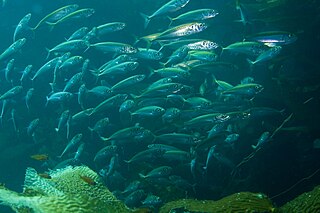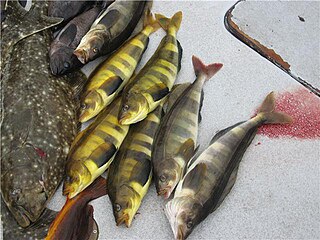
Salmon is the common name for several commercially important species of euryhaline ray-finned fish from the genera Salmo and Oncorhynchus of the family Salmonidae, native to tributaries of the North Atlantic (Salmo) and North Pacific (Oncorhynchus) basins. Other closely related fish in the same family include trout, char, grayling, whitefish, lenok and taimen, all coldwater fish of the subarctic and cooler temperate regions with some sporadic endorheic populations in Central Asia.

A tuna is a saltwater fish that belongs to the tribe Thunnini, a subgrouping of the Scombridae (mackerel) family. The Thunnini comprise 15 species across five genera, the sizes of which vary greatly, ranging from the bullet tuna up to the Atlantic bluefin tuna, which averages 2 m (6.6 ft) and is believed to live up to 50 years.

Mackerel is a common name applied to a number of different species of pelagic fish, mostly from the family Scombridae. They are found in both temperate and tropical seas, mostly living along the coast or offshore in the oceanic environment.

Halibut is the common name for three species of flatfish in the family of right-eye flounders. In some regions, and less commonly, other species of large flatfish are also referred to as halibut.

The milkfish is a widespread species of ray-finned fish found throughout the Indo-Pacific. It is the sole living species in the family Chanidae, and the only living member of the genus Chanos. The repeating scientific name (tautonym) is from Greek khanos. They are grouped in the order Gonorhynchiformes and are most closely related to the Ostariophysi—freshwater fishes such as carps, catfish, and loaches.

The Cyclopteridae are a family of marine fishes, commonly known as lumpsuckers or lumpfish, in the order Scorpaeniformes. They are found in the cold waters of the Arctic, North Atlantic, and North Pacific oceans. The greatest number of species are found in the North Pacific. The family name Cyclopteridae derives from the Greek words κύκλος (kyklos), meaning "circle", and πτέρυξ (pteryx), meaning "wing" or "fin", in reference to the circle-shaped pectoral fins of most of the fish in this family.

Centropomus is a genus of predominantly marine fish comprising the family Centropomidae. The type species is Centropomus undecimalis, the common snook. Commonly known as snooks or róbalos, the Centropomus species are native to tropical and subtropical waters of the western Atlantic and eastern Pacific Oceans.

Pink salmon or humpback salmon is a species of euryhaline ray-finned fish in the family Salmonidae. It is the type species of the genus Oncorhynchus, and is the smallest and most abundant of the seven officially recognized species of salmon. The species' scientific name is based on the Russian common name for this species gorbúša (горбуша), which literally means humpie.

The largehead hairtail or beltfish is a member of the cutlassfish family, Trichiuridae. This common to abundant species is found in tropical and temperate oceans throughout the world. The taxonomy is not fully resolved, and the Atlantic, East Pacific and Northwest Pacific populations are also known as Atlantic cutlassfish, Pacific cutlassfish and Japanese cutlassfish, respectively. This predatory, elongated fish supports major fisheries.

The Pacific jack mackerel, also known as the Californian jack mackerel or simply jack mackerel, is an abundant species of pelagic marine fish in the jack family, Carangidae. It is distributed along the western coast of North America, ranging from Alaska in the north to the Gulf of California in the south, inhabiting both offshore and inshore environments. The Pacific jack mackerel is a moderately large fish, growing to a maximum recorded length of 81 cm, although commonly seen below 55 cm. It is very similar in appearance to other members of its genus, Trachurus, especially T. murphyi, which was once thought to be a subspecies of T. symmetricus, and inhabits waters further south. Pacific jack mackerel travel in large schools, ranging up to 600 miles offshore and to depths of 400 m, generally moving through the upper part of the water column.

An anchovy is a small, common forage fish of the family Engraulidae. Most species are found in marine waters, but several will enter brackish water, and some in South America are restricted to fresh water.

The Atka mackerel is a mackerel in the family Hexagrammidae. Atka mackerel are common in the northern Pacific Ocean, and are one of only two members of the genus Pleurogrammus – the other being the Arabesque greenling. The Atka mackerel was named for Atka Island, the largest island of the Andreanof islands, a branch of the Aleutians.
Cyclopteropsis is a genus of marine ray-finned fishes belonging to the family Cyclopteridae, the lumpfishes or lumpsuckers. These small lumpfishes are found in the North Pacific and Arctic Oceans.
John Ernest "Jack" Randall was an American ichthyologist and a leading authority on coral reef fishes. Randall described over 800 species and authored 11 books and over 900 scientific papers and popular articles. He spent most of his career working in Hawaii. He died in April 2020 at the age of 95.
Gymnelus is a genus of small fish in the family Zoarcidae found in the Arctic Ocean, and adjacent parts of the North Pacific and North Atlantic. They are highly variable in color, which has resulted in the description of several taxa now considered invalid.
Cyclopteropsis bergi is a species of lumpfish native to the Northwest Pacific, where it is found at depths of 20 to 200 m. This species reaches 7 cm in total length and occurs in the Bering Sea, the Sea of Okhotsk, and the Sea of Japan where it may be found off of North Korea and Sado Island. In 2011, a single individual of the species was also reported from Sokcho, South Korea.
Cyclopteropsis brashnikowi is a species of lumpfish native to the Sea of Okhotsk and the Northwest Pacific off of the Kuril Islands, where it is found at a depth of 30 to 303 metres. Adult individuals of the species have been noted to resemble the related species C. popovi, suggesting that the two species names may be synonymous. It is of disputed classification, being considered a species of Eumicrotremus by some authors, although sources such as FishBase, WoRMS, and ITIS do not follow this classification.
Cyclopteropsis inarmatus, also known as the bumpy lumpsucker, is a species of marine ray-finned fish belonging to the family Cyclopteridae, the lumpfishes or lumpsuckers. This fish is found in the North Pacific, where it occurs in the Bering Sea and the Sea of Okhotsk. In the Bering Sea, it can be found between Cape Navarin and Cape Olyutorskiy, whereas in the Sea of Okhotsk it is seen primarily off of the Kamchatka Peninsula. It inhabits a depth range of 76 to 150 m and reaches 6.4 cm in total length. It is a small demersal (bottom-dwelling) fish that may be seen in rocky areas.
Cyclopteropsis lindbergi is a species of lumpfish native to the Bering Sea, the Sea of Okhotsk, and the Sea of Japan. It is found at a depth range of 20 to 200 m, and it may reach 7 cm in total length.











